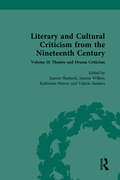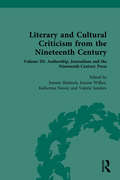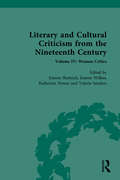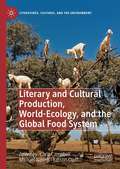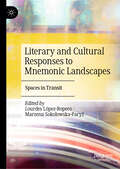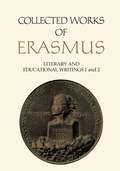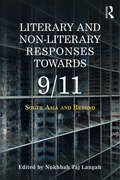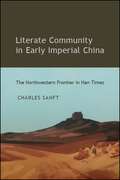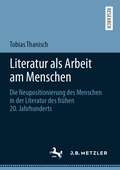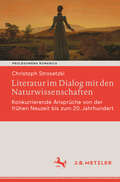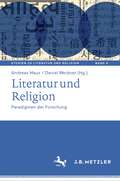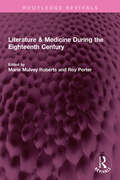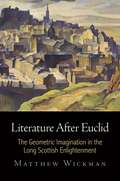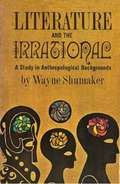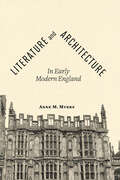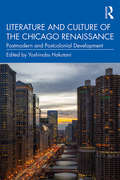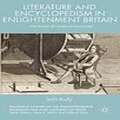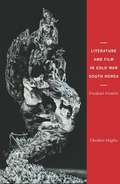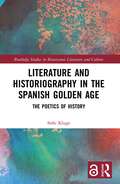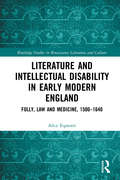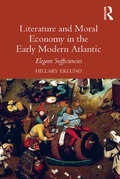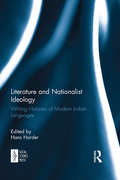- Table View
- List View
Literary and Cultural Criticism from the Nineteenth Century: Volume II: Theatre and Drama Criticism
by Joanne Shattock Katherine Newey Joanne Wilkes Valerie SandersThis collection of primary sources examines literary and cultural criticism over the long nineteenth century. This volume explores the subject of drama criticism. This set will be of great interest to students of literary history.
Literary and Cultural Criticism from the Nineteenth Century: Volume III: Authorship, Journalism and the Nineteenth-Century Press
by Joanne Shattock Katherine Newey Joanne Wilkes Valerie SandersThis collection of primary sources examines literary and cultural criticism over the long nineteenth century. This volume explores the subject of the periodical and newspaper press. This set will be of great interest to students of literary history.
Literary and Cultural Criticism from the Nineteenth Century: Volume IV: Women Critics
by Joanne Shattock Katherine Newey Joanne Wilkes Valerie SandersThis collection of primary sources examines literary and cultural criticism over the long nineteenth century. This volume explores the literary criticism written by women. This set will be of great interest to students of literary history.
Literary and Cultural Production, World-Ecology, and the Global Food System (Literatures, Cultures, and the Environment)
by Chris Campbell Michael Niblett Kerstin OloffLiterary and Cultural Production, World-Ecology, and the Global Food System marks a significant intervention into the field of literary food studies. Drawing on new work in world literature, cultural studies, and environmental studies, the essays gathered here explore how literary and cultural texts have represented and responded to the global food system from the late nineteenth century to the present day. Covering topics such as the impact of colonial monocultures and industrial agriculture, enclosure and the loss of the commons, the meatification of diets, the toxification of landscapes, and the consequences of climate breakdown, the volume ranges across the globe, from Thailand to Brazil, Cyprus to the Caribbean. Whether it is anxieties over imported meat in late Victorian Britain, labour struggles on Guatemalan banana plantations, or food dependency in Puerto Rico, the contributors to this volume show how fiction, poetry, drama, film, and music have critically explored and contributed to food cultures worldwide.
Literary and Cultural Responses to Mnemonic Landscapes: Spaces in Transit
by Lourdes López-Ropero Marzena Sokołowska-ParyżThis book offers a profound exploration of "spaces in transit," a concept that bridges urban spaces, natural environments, and the archival and architectural echoes of the past with their representations in literature, art, and commemorative practices. Through 14 meticulously crafted essays, this volume delves into the intricate interplay between spatial and cultural memory, framed by theories of geocriticism, feminism, race, postcolonialism, and more. Key concepts such as "deep spaces," "implicative spaces," and "landmark poetic spaces" are introduced, inviting readers to consider the fluidity and mutability of memory-laden sites. The essays critically examine how these spaces are continually reinterpreted and renegotiated, challenging ideologically rigid narratives. The volume is organized into three thematic parts: "Historyscapes," "Artscapes," and "Mythic Urbanscapes and Naturescapes," each offering unique insights into the mnemonic appropriations of physical and literary spaces. This collection is essential for scholars and students in urban studies, environmental studies, memory, and literary studies, providing a comprehensive study of contemporary cultural and theoretical trends. It invites readers to rethink the sedentary-nomadic continuum of memory and space, offering a fresh perspective on the dynamic nature of cultural and collective memory.
Literary and Educational Writings, 1 and 2: Volume 1: Antibarbari / Parabolae. Volume 2: De copia / De ratione studii (Collected Works of Erasmus #23-24)
by Craig Thompson Desiderius ErasmusThese volumes are the first in a series containing works by Erasmus 'that concern literature and education': interests which to him were scarcely separable. The aim of Erasmian education was a civilized life, expressed in Christian piety and the fulfilment of public and private duties and embellished by learning and literature. Towards these ends the soundest training for youth was what Erasmus often called bonne litterae, 'good letters,' a literary and rhetorical training based on Greek and Latin authors. For centuries the classical curriculum was the core of liberal education, and Erasmus was long regarded as its exemplar. Though never a university teacher except briefly at Cambridge (1311-14), he was a 'teacher of teachers' through his treatises on pedagogy and rhetoric and his many works of scholarship. The four works presented here in annotated translations are characteristic expressions of his dedication to learning and his confidence in the values of classical literature for the modern world of his time. Antibarbari (1520), translated and annotated by Margaret Mann Phillips, is a defence of the humanities against ignorant and misguided critics who question both their supposed worth and the appropriateness of pagan writings for Christian pupils. The reply of Erasmus becomes a manifesto on behalf of reason, scholarship, and literature. As for paganism, he insists that if secular knowledge is used properly it cannot harm but must help Christians. 'None of the liberal disciplines is Christian' because they all antedated Christianity, yet they 'all concern Christ' because they can be put to Christian uses. Parabolae (1514), translated and annotated by R.A.B. Mynors, a work that 'contributes eminently to style,' is a collection of similitudes drawn from observations of men, customs, and nature. Many are culled from Plutarch and Seneca, but for those from Seneca, and from Aristotle, the moral applications are added by Erasmus. As an exercise in the rhetoric of moral philosophy - 'many jewels in one small box,' Erasmus terms it-this book quickly became popular and long remained so. De copia (1512), translated and annotated by Betty I. Knott, is not a plan for the entire curriculum but a treatise on the 'abundant' or rich style in writing and speaking Latin, a guide to attaining fluency and variety in discourse. As a manual for students De copia broke new ground. It was a remarkably successful work, used in schools in many lands for generations. From 1312 to 1600, more than 130 printings are recorded. De ratione studii (1312), translated and annotated by Brian McGregor, furnishes a concise but clear exposition of the curriculum, text, and methods of Erasmus' programme for liberal studies in grammar schools. Here as in all of his writings on education, language is the heart of the matter. The main goals are accurate, effective expression and communication in Latin, though Erasmus expects much besides literature to be learned from the study of literature. He emphasizes the necessity for competent and sympathetic teachers. Each translation is introduced by the translator, and a general introduction by the editor discusses the significance of each of the works, its relation to the others, and its subsequent fortunes. Wallace K. Ferguson provides an introductory essay, 'The Works of Erasmus.' Volumes 23 and 24 of the Collected Works of Erasmus series – Two-volume set.
Literary and Non-literary Responses Towards 9/11: South Asia and Beyond
by Nukhbah Taj LangahThis book presents a range of analytical responses towards 9/11 through a critical review of literary, non-literary and cultural representations. The contributors examine the ways in which this event has shaped and complicated the relationship between various national and religious identities in contemporary world history. Unlike earlier studies on the topic, this work reconciles both eclectic and pragmatic approaches by analyzing the stereotypes of nationhood and identities while also questioning theoretical concepts in the context of the latest political developments. The chapters focus on discourses, themes, imagery and symbolism from across fiction and non-fiction, films, art, music, and political, literary and artistic movements. The volume addresses complexities arising within different local contexts (e.g., Hunza and state development); surveys broader frameworks in South Asia (representations of Muslims in Bollywood films); and gauges international impact (U.S. drone attacks in Islamic countries; treatment meted out to Muslims in Europe). It also connects these with relevant theories (e.g., Orientalism) and policy perspectives (e.g., Patriotic Act). The authors further discuss the consequences for minorities and marginalization, cultural relativism vs. ethnocentrism, the clash of civilizations, fundamentalism, Islamization and post-9/11 ‘Islamophobia’. This book will be useful to scholars and researchers of South Asian literature, Islamic studies, literary criticism, political sociology, anthropology and cultural studies, those in the media and the general reader.
Literate Community in Early Imperial China: The Northwestern Frontier in Han Times (SUNY series in Chinese Philosophy and Culture)
by Charles SanftWinner of the 2020 James Henry Breasted Prize in Ancient History presented by the American Historical AssociationHonorable Mention, 2021 Joseph Levenson Pre-1900 Book Prize presented by the Association for Asian StudiesThis book examines ancient written materials from China's northwestern border regions to offer fresh insights into the role of text in shaping society and culture during the Han period (206/2 BCE–220 CE). Left behind by military installations, these documents—wooden strips and other nontraditional textual materials such as silk—recorded the lives and activities of military personnel and the people around them. Charles Sanft explores their functions and uses by looking at a fascinating array of material, including posted texts on signaling across distances, practical texts on brewing beer and evaluating swords, and letters exchanged by officials working in low rungs of the bureaucracy. By focusing on all members of the community, he argues that a much broader section of early society had meaningful interactions with text than previously believed. This major shift in interpretation challenges long-standing assumptions about the limited range of influence that text and literacy had on culture and society and makes important contributions to early China studies, the study of literacy, and to the global history of non-elites.
Literatur als Arbeit am Menschen: Die Neupositionierung des Menschen in der Literatur des frühen 20. Jahrhunderts
by Tobias ThanischDie zunehmende Ausdifferenzierung der Humanwissenschaften stellt zu Beginn des 20. Jahrhunderts das bisherige Bild des Menschen in Frage, ohne dabei ein konsistentes Folgekonzept liefern zu können. Als Reaktion auf diese unbestimmte Positionierung des Menschen entwerfen Autoren verschiedenster Strömungen eigene Konzepte eines „neuen Menschen“, an dessen Verwirklichung sie aktiv mitarbeiten. Die vorliegende Arbeit stellt anhand dreier Textbeispiele aus verschiedenen Nationalliteraturen unterschiedliche Konzepte vor dem Hintergrund philosophischer und wissensgeschichtlicher Zusammenhänge vor. Sie liefert damit auch einen Anknüpfungspunkt an aktuelle Konzepte des Post- und Transhumanismus.
Literatur im Dialog mit den Naturwissenschaften: Konkurrierende Ansprüche von der frühen Neuzeit bis zum 20. Jahrhundert (Prolegomena Romanica. Beiträge zu den romanischen Kulturen und Literaturen)
by Christoph StrosetzkiDie These des Buches ist, dass in der frühen Neuzeit die Literatur den Vorrang vor der Naturbetrachtung beanspruchte. Verschiebungen gab es über Phasen zeitweiliger Parität, der Priorität der Naturwissenschaften im 19. Jahrhundert bis zu deren Kritik im 20. Jahrhundert von Seiten der Literatur. Dargestellt werden diese Entwicklungen in Frankreich und im spanischsprachigen Raum, wobei auch Deutschland und England Berücksichtigung finden: Während Montaigne, Pedro Mexía, Pérez de Oliva, Vives und Gracián der Literatur die Priorität geben, stellt Pascal dem „esprit de finesse“ den „esprit de géométrie“ gegenüber und eröffnet eine Kontroverse, die Linné und Buffon fortsetzen. Aufklärer wie Voltaire orientieren sich am englischen Modell. Hier führen Locke und Hume Erfahrungswissenschaften ein, deren Fortschritte Rousseau kritisiert. Setzen sich im 19. Jahrhundert Balzac und Pérez Galdós mit den Naturwissenschaften auseinander, werden dann bei Zola Darwin und Comte zu Vorbildern. Die Aporien des naturwissenschaftlichen Denkens schließlich zeigen Ortega y Gasset, Borges und Sábato auf.
Literatur und Religion: Paradigmen der Forschung (Studien zu Literatur und Religion / Studies on Literature and Religion #6)
by Daniel Weidner Andreas MauzIn den letzten Jahren hat sich die Forschung zu den Beziehungen von Literatur und Religion unverkennbar intensiviert. Der vorliegende Band unterzieht sie einer Bestandsaufnahme und fragt nach den Paradigmen, die diese Arbeiten geleitet haben und leiten. Welche Fragen stellt die Forschung – welche nicht (mehr)? Welche theoretischen und methodischen Orientierungen bestimmen den Diskurs? Wie könnte er sich in Zukunft entwickeln? Lassen sich disziplinäre oder auch interdisziplinäre Paradigmenwechsel ausmachen? Die Beiträge rekonstruieren die Forschungsgeschichte etwa zum Trauerspiel, zu Klopstock oder zum antiken Roman und geben Überblicke über breitere Diskurse wie die literaturwissenschaftlich orientierten Bibelwissenschaften, die religionsbezogene Comic-Forschung oder die US-amerikanische Debatte über „Literature and Religion“.
Literature & Medicine During the Eighteenth Century (Routledge Revivals)
by Roy Porter Marie Mulvey RobertsFirst published in 1993, Literature & Medicine During the Eighteenth Century analyses the close interplay of medicine and literature by paying special attention to questions of body language and the representation of inner life. Although today, medicine and literature are widely seen as falling on different sides of the ‘two cultures’ divide, this was not so in the eighteenth century when doctors, scientists, writers, and artists formed a well-integrated educated elite. Locke, Smollett and Goldsmith were doctors, and physicians such as Erasmus Darwin doubled as poets. Written by leading historians of medicine and eighteenth-century literary critics, this book uncovers the interconnections between medical and psychological theory and ideas of taste, beauty, and genius. Its contributors explore the rich cultural milieu of the period and investigate the ways in which medicine itself contributed to informing a gendered discourse of the world. This book will be of interest to historians, literary scholars and medical historians.
Literature After Euclid: The Geometric Imagination in the Long Scottish Enlightenment
by Matthew WickmanLiterature After Euclid tells the story of the creative adaptation of geometry in Scotland during and after the long eighteenth century. It argues that diverse attempts in literature and philosophy to explain or even emulate the geometric achievements of Isaac Newton and others resulted in innovations that modify our understanding of descriptive and bardic poetry, the aesthetics of the picturesque, and the historical novel. Matthew Wickman's analyses of these innovations in the work of Walter Scott, Robert Burns, James Thomson, David Hume, Thomas Reid, and other literati change how we perceive the Scottish Enlightenment and the later, modernist ethos that purportedly relegated the "classical" Enlightenment to the dustbin of history. Indeed, the Scottish Enlightenment's geometric imagination changes how we see literary history itself.
Literature And The Irrational; A Study In Anthropological Backgrounds: A Study In Anthropological Backgrounds
by Wayne ShumakerThe author analyzes the primitive mind as described by modern anthropologists, and seeks to establish the continuity of creative literary patterns with those of primitive consciousness and to show that these patterns are accessible to modern man since they are also those of childish thought.-Print ed.
Literature Connections: The Canterbury Tales Sourcebook
by Mcdougal Littell12th Grade Literature Sourcebook
Literature and Architecture in Early Modern England
by Anne M. MyersOur built environment inspires writers to reflect on the human experience, discover its history, or make it up.Buildings tell stories. Castles, country homes, churches, and monasteries are "documents" of the people who built them, owned them, lived and died in them, inherited and saved or destroyed them, and recorded their histories. Literature and Architecture in Early Modern England examines the relationship between sixteenth- and seventeenth-century architectural and literary works. By becoming more sensitive to the narrative functions of architecture, Anne M. Myers argues, we begin to understand how a range of writers viewed and made use of the material built environment that surrounded the production of early modern texts in England. Scholars have long found themselves in the position of excusing or explaining England’s failure to achieve the equivalent of the Italian Renaissance in the visual arts. Myers proposes that architecture inspired an unusual amount of historiographic and literary production, including poetry, drama, architectural treatises, and diaries. Works by William Camden, Henry Wotton, Ben Jonson, Andrew Marvell, George Herbert, Anne Clifford, and John Evelyn, when considered as a group, are texts that overturn the engrained critical notion that a Protestant fear of idolatry sentenced the visual arts and architecture in England to a state of suspicion and neglect.
Literature and Citizenship in the Age of Revolution: A Wish for Air and Liberty (Routledge Interdisciplinary Perspectives on Literature)
by Mitchell GauvinCitizenship is at the forefront of popular imagination as political movements and state governments around the world traffic in anti-immigrant rhetoric and call for increased policing of borders. Literature and Citizenship in the Age of Revolution: A Wish for Air and Liberty looks back to a critical historical juncture in the development of citizenship to uncover how literature contoured and contested imaginings of citizenship. While territory and the nation-state often frame our understanding of citizenship, this book focuses on how non-citizens, foreigners, and strangers have long been central to citizenship’s coherence. Rather than rootedness, literary texts exposed the circulations of persons, ideas, and affections at the heart of citizenship. This book brings together an unlikely combination of writers—Olaudah Equiano, Jane Austen, Mary Shelley, and Herman Melville—to show how literature in the Age of Revolution exposed contradictions in notions of liberty and slavery that impacted how citizenship was conceived and practiced.
Literature and Culture of the Chicago Renaissance: Postmodern and Postcolonial Development
by Yoshinobu HakutaniThe Chicago Renaissance has long been considered a less important literary movement than the Harlem Renaissance. While the Harlem Renaissance began and flourished during the 1920s, but faded during the 1930s, the Chicago Renaissance originated between 1890 and 1910, gathered momentum in the 1930s, and paved the way for the postmodern and postcolonial developments in American Literature. To portray Chicago as a modern, spacious, cosmopolitan city, the writers of the Chicago Renaissance developed a new style of writing based on a distinct cultural aesthetic that reflected ethnically diverse sentiments and aspirations. Whereas the Harlem Renaissance was dominated by African American writers, the Chicago Renaissance originated from the interactions between African and European American writers. Much like modern jazz, writings in the movement became a hybrid, cross-cultural product of black and white Americans. The second period of the movement developed at two stages. In the first stage, the older generation of African American writers continued to deal with racial issues. In the second stage, African American writers sought solutions to racism by comparing American culture with other cultures. The younger generation of African American writers, such as Ishmael Reed, Charles Johnson, and Colson Whitehead, followed their predecessors and explored Confucianism, Buddhist Ontology, and Zen. This volume features essays by both veteran African Americanists and upcoming young critics. It is highlighted by essays from scholars located around the globe, such as Toru Kiuchi of Japan, Yupei Zhou of China, Mamoun Alzoubi of Jordan, and Babacar M'Baye of Senegal. It will be invaluable reading for students of Americanists at all levels.
Literature and Encyclopedism in Enlightenment Britain
by Seth RudyAt a moment when Google seeks "to organize the world's information and make it universally accessible and useful," this book tells the story of long-term aspirations, first in ancient epic and then in a wide range of literary and non-literary works from the early modern era and British Enlightenment, to comprehend, record, and disseminate complete knowledge of the world. It is also a story of the persistent failure of these aspirations, their collapse in the late eighteenth century, and the subsequent redefinition of completeness in modern literary and disciplinary terms. The book argues that the pursuit of complete knowledge advanced the separation of epic from encyclopedia, literature from "Literature," and the sciences from the humanities; it demonstrates that the distinctions between "high" and "low," ephemeral and eternal, useful and useless that persist today all stem from the concepts of completeness that emerged during and as a result of the Enlightenment.
Literature and Film in Cold War South Korea: Freedom's Frontier (Columbia Studies In Terrorism And Irregular Warfare Ser.)
by Theodore HughesKorean writers and filmmakers crossed literary and visual cultures in multilayered ways under Japanese colonial rule (1910–1945). Taking advantage of new modes and media that emerged in the early twentieth century, these artists sought subtle strategies for representing the realities of colonialism and global modernity. Theodore Hughes begins by unpacking the relations among literature, film, and art in Korea's colonial period, paying particular attention to the emerging proletarian movement, literary modernism, nativism, and wartime mobilization. He then demonstrates how these developments informed the efforts of post-1945 writers and filmmakers as they confronted the aftershocks of colonialism and the formation of separate regimes in North and South Korea. Hughes puts neglected Korean literary texts, art, and film into conversation with studies on Japanese imperialism and Korea's colonial history. At the same time, he locates post-1945 South Korean cultural production within the transnational circulation of texts, ideas, and images that took place in the first three decades of the Cold War. The incorporation of the Korean Peninsula into the global Cold War order, Hughes argues, must be understood through the politics of the visual. In Literature and Film in Cold War South Korea, he identifies ways of seeing that are central to the organization of a postcolonial culture of division, authoritarianism, and modernization.
Literature and Historiography in the Spanish Golden Age: The Poetics of History (Routledge Studies in Renaissance Literature and Culture)
by Sofie KlugeGolden Age departures in historiography and theory of history in some ways prepared the ground for modern historical methods and ideas about historical factuality. At the same time, they fed into the period’s own "aesthetic-historical culture" which amalgamated fact and fiction in ways modern historians would consider counterfactual: a culture where imaginative historical prose, poetry and drama self-consciously rivalled the accounts of royal chroniclers and the dispatches of diplomatic envoys; a culture dominated by a notion of truth in which skilful construction of the argument and exemplarity took precedence over factual accuracy. Literature and Historiography in the Spanish Golden Age: The Poetics of History investigates this grey area backdrop of modern ideas about history, delving into a variety of Golden Age aesthetic-historical works which cannot be satisfactorily described as either works of literature or works of historiography but which belong in between these later strictly separate categories.
Literature and Intellectual Disability in Early Modern England: Folly, Law and Medicine, 1500-1640 (Routledge Studies in Renaissance Literature and Culture)
by Alice EquestriFools and clowns were widely popular characters employed in early modern drama, prose texts and poems mainly as laughter makers, or also as ludicrous metaphorical embodiments of human failures. Literature and Intellectual Disability in Early Modern England: Folly, Law and Medicine, 1500–1640 pays full attention to the intellectual difference of fools, rather than just their performativity: what does their total, partial, or even pretended ‘irrationality’ entail in terms of non-standard psychology or behaviour, and others’ perception of them? Is it possible to offer a close contextualised examination of the meaning of folly in literature as a disability? And how did real people having intellectual disabilities in the Renaissance period influence the representation and subjectivity of literary fools? Alice Equestri answers these and other questions by investigating the wide range of significant connections between the characters and Renaissance legal and medical knowledge as presented in legal records, dictionaries, handbooks, and texts of medicine, natural philosophy, and physiognomy. Furthermore, by bringing early modern folly in closer dialogue with the burgeoning fields of disability studies and disability theory, this study considers multiple sides of the argument in the historical disability experience: intellectual disability as a variation in the person and as a difference which both society and the individual construct or respond to. Early modern literary fools’ characterisation then emerges as stemming from either a realistic or also from a symbolical or rhetorical representation of intellectual disability.
Literature and Modern Time: Technological Modernity; Glimpses of Eternity; Experiments with Time
by Trish FergusonLiterature and Modern Time is a collection of essays that explore literature in the context of a wave of challenges to linear conceptions of time introduced by thinkers such as Bergson, Einstein, McTaggart, Freud and Nietzsche. These challenges were not uniform in character. The volume will demonstrate that literature of the era under scrutiny was not simply reacting to new theories of time—in some cases it is actually inspiring and anticipating them. Thus Literature and Modern Time promises to offer a genuine dialogue between literature and time theory and in doing so will uncover and examine influences and connections— sometimes unexpected—between philosophers and writers of the era. It will examine literary attempts to transcend and escape time and also challenge rupture-based accounts of modernist time by demonstrating that literary texts commonly associated with brokenness, decline or stasis, also, at the same time, maintain faith in healing, renewal and mobility.This collection contains interdisciplinary research of the quite highest kind - to see so many different kinds of time - narrative, historical, mechanical, subjective, non-linear time, myth and nostalgia - as well as time/space discussed here is very stimulating indeed.Professor Simon James
Literature and Moral Economy in the Early Modern Atlantic: Elegant Sufficiencies
by Hillary EklundGrounded in the literary history of early modern England, this study explores the intersection of cultural attitudes and material practices that shape the acquisition, circulation, and consumption of resources at the turn of the seventeenth century. Considering a formally diverse and ideologically rich array of texts from the period - including drama, poetry, and prose, as well as travel narrative and early modern political and literary theory - this book shows how ideas about what is considered 'enough' adapt to changing material conditions and how cultural forces shape those adaptations. Literature and Moral Economy in the Early Modern Atlantic traces how early modern English authors improvised new models of sufficiency that pushed back the threshold of excess to the frontier of the known world itself. The book argues that standards of economic sufficiency as expressed through literature moved from subsistence toward the increasing pursuit of plenty through plunder, trade, and plantation. Author Hillary Eklund describes what it means to have enough in the moral economies of eating, travel, trade, land use and public policy.
Literature and Nationalist Ideology: Writing Histories of Modern Indian Languages (Ssp Ser.)
by Hans HarderWriting histories of literature means making selections, passing value judgments, and incorporating or rejecting foregoing traditions. The book argues that in many parts of India, literary histories play an important role in creating a cultural ethos. They are closely linked with nationalism in general and various regional ‘sub-nationalisms’ in particular. The contributors to this volume look at a great variety of aspects of the historiography of modern regional languages of India. Please note: Taylor & Francis does not sell or distribute the Hardback in India, Pakistan, Nepal, Bhutan, Bangladesh and Sri Lanka
